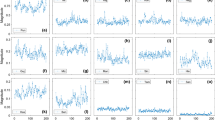Abstract
Spoken Language Identification (SLI) is the process of capturing a type of language of a speaker. In this research paper, the used database is created in three different languages, Gujarati, Hindi, and English. Language classification is performed using features like MFCC (Mel Frequency Cepstral Coefficients), Pitch, and average energy. Accuracy values of the created database are evaluated and compared using various pattern classifiers, namely, Fine Tree, Linear Discriminant, Gaussian Naïve Bayes, Linear SVM, Fine KNN, and feed-forward neural network in MATLAB 2019. Performance using individual speech features and hybrid features are compared. Training time of all the classifiers is also evaluated to decide the best among all classifiers.
Access this chapter
Tax calculation will be finalised at checkout
Purchases are for personal use only
Similar content being viewed by others
References
D. Deshwal, P. Sangwan, D. Kumar, Feature extraction methods in language identification: a survey. Wirel. Pers. Commun. 107 (2019)
D. Nandi, Language Identification—A Brief Review (2015)
A.B. Nassif, I. Shahin, I. Attilim, Speech recognition using deep neural networks: a systematic review. IEEE Access 7(99), 19143–19165 (2019)
V. Tank, S.K. Hadia, Creation of speech corpus for emotion analysis in Gujarati language and its evaluation by various speech parameters. IJECE 10(5), 4752–4758 (2020)
J. Anjana, S.S. Poorna, Language identification from speech features using SVM and LDA (2018), pp. 1–4
M. Zampieri, A. Ciobanu, L. Dinu, Native language identification on text and speech (2017)
P. Athira, S.S. Poorna, Deep learning based language identification system from speech (2019), pp. 1094–1097
S. Ishimitsu, Speech recognition method and speech recognition apparatus. J. Acoust. Soc. Am. 94(109), 3538 (2018)
Z. Song, English speech recognition based on deep learning with multiple features. Computing 102, 663–682 (2020)
H. Mukherjee, A. Dhar, S.K. Obaidullah, K.C. Santosh, S. Phadikar, K. Roy, A recurrent neural network-based approach to automatic language identification from speech (2020)
I. Lopez-Moreno, J. Gonzalez-Dominguez, D. Martinez, O. Plchot, J. Gonzalez-Rodriguez, P. Moreno, On the use of deep feedforward neural networks for automatic language identification. Comput. Speech Lang. 40 (2016)
C. Chandak, Z. Raeesy, A.L. Rastrow, H. Yuzong, W. Xiangyang, J. Dong, M. Roland, Streaming language identification using combination of acoustic representations and ASR hypotheses (2020)
R. Latypov, R. Nigmatullin, E. Stolov, Automatic spoken language identification by digital signal processing methods. Tatar Russ. Lang. (2017)
J. Chakraborty, S. Nath, S. Nirmala, K. Samudravijaya, Language identification of Assamese, Bengali and English Speech (2018) pp. 177–181
S. Jothilakshmi, V. Ramalingam, Sengottayan, A hierarchical language identification system for Indian languages. Digit. Signal Process. 22, 544–553 (2012)
C. Madhu, A. George, L. Mary, Automatic language identification for seven Indian languages using higher level features, in IEEE International Conference on Signal Processing, Informatics, Communication and Energy Systems (SPICES) (2017), pp. 1–6
S. Koolagudi, D. Rastogi, Spoken language identification using spectral features. Commun. Comput. Inf. Sci. 306, 496–497 (2012)
A. Sangwan, M. Mehrabani, J.H.L. Ansen, Automatic language analysis and identification based on speech production knowledge, in IEEE International Conference on Acoustics, Speech and Signal Processing (2010), pp. 5006–5009
S. Maity, A.K. Vuppala, K.S. Rao, D. Nandi, IITKGP-MLILSC speech database for language identification, in IEEE National Conference on Communications (NCC) (2012)
H. Ali, S.N. Tran, E. Benetos, Speaker recognition with hybrid features from a deep belief network. Neural Comput. Appl. 29(6), 13–19 (2018)
K. Hwamin, P. Jeong-Sik, Automatic language identification using speech rhythm features for multi-lingual speech recognition. Appl. Sci. 10, 2225 (2020)
M. Leen, B. Yegnanarayana, Prosodic features for language identification (2008), pp. 57–62
J. Fan, N. Zhou, J. Peng, L. Gao, Hierarchical learning of tree classifiers for large-scale plant species identification. IEEE Trans. Image Process. 24(11), 4172–4184 (2015). https://doi.org/10.1109/TIP.2015.2457337
A.N. Younis, F.M. Remo, Distinguish musical symbol printed using the linear discriminant analysis LDA and similarity scale. Int. J. Comput. Appl. 179(47), 20–24 (2018)
I.H. Sarker, A.S.M. Kayes, P. Watters, Effectiveness analysis of machine learning classification models for predicting personalized context aware smart phone usage. J. Big Data 6(57), 01–28 (2019)
Y. Zhang, Support vector machine classification algorithm and its application, in Information Computing and Applications. ICICA 2012., ed. by C. Liu, L. Wang, A. Yang. Communications in Computer and Information Science, vol. 308 (Springer, Berlin, Heidelberg, 2012). https://doi.org/10.1007/978-3-642-34041-3_27
S. Taneja, C. Gupta, K. Goyal, D. Gureja, An enhanced K-nearest neighbor algorithm using information gain and clustering, in 2014 Fourth International Conference on Advanced Computing & Communication Technologies, Rohtak (2014), pp. 325–329. https://doi.org/10.1109/ACCT.2014.22.
A. Jamatia, A. Das, B. Gambäck, Deep learning-based language identification in English-Hindi-Bengali code-mixed social media corpora. J. Intell. Syst. 28(3), 399–408 (2019). https://doi.org/10.1515/jisys-2017-0440
Author information
Authors and Affiliations
Corresponding author
Editor information
Editors and Affiliations
Rights and permissions
Copyright information
© 2022 The Author(s), under exclusive license to Springer Nature Singapore Pte Ltd.
About this paper
Cite this paper
Tank, V., Manavadaria, M., Dudhat, K. (2022). A Novel Approach for Spoken Language Identification and Performance Comparison Using Machine Learning-Based Classifiers and Neural Network. In: Thakkar, F., Saha, G., Shahnaz, C., Hu, YC. (eds) Proceedings of the International e-Conference on Intelligent Systems and Signal Processing. Advances in Intelligent Systems and Computing, vol 1370. Springer, Singapore. https://doi.org/10.1007/978-981-16-2123-9_42
Download citation
DOI: https://doi.org/10.1007/978-981-16-2123-9_42
Published:
Publisher Name: Springer, Singapore
Print ISBN: 978-981-16-2122-2
Online ISBN: 978-981-16-2123-9
eBook Packages: Intelligent Technologies and RoboticsIntelligent Technologies and Robotics (R0)




